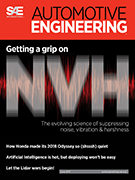Magazine

MOBILITY ENGINEERING: September 2017
2017-09-01
Connected commercial vehicles bring cybersecurity to the fore Connectivity, automation and electrification will drive vehicle development in the near future, say industry experts attending the revamped SAE COMVEC 17 event.













